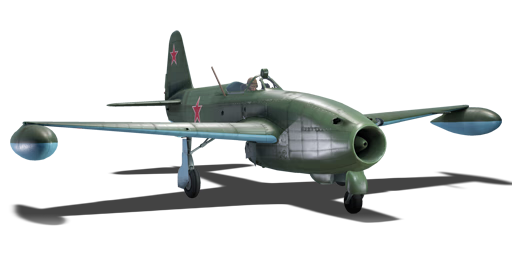



The Yak-17 was a further development of the Yak-15 jet fighter developed by the Soviet Union. The Yak-17 was also the basis for the Yak-23 and it functioned as the main training fighter for pilots transitioning from piston-engine fighters to jet engines. The Yak-17 was very similar to the Yak-15, it retained the airframe of the Yak-3 and only addressed a few issues to make the fighter more viable. It introduced a bulletproof glass pane in the front of the cockpit as well as extra fuel tanks for longer range. The biggest improvement was the introduction of a modern landing gear like the one present in the MiG-9. Only 430 units were made and most of them were eventually given to the Czech and Polish air forces.
It was introduced in Update 1.33. Similar to its hybrid predecessors, the Yak-17 is arguably one of the most underestimated aircraft in the game. Although its stat card reveals what would be considered "sub-par" performance and armament, the Yak-17 is both a unique and deadly fighter. Unlike its propeller-driven counterparts, this first generation jet aircraft wields the ability to hold on to energy in a straight line, whereas prop aircraft will slowly lose speed. This, coupled with its good rate of turn, allows the Yak-17 to defend itself against both propeller and jet-powered aircraft, which is what it will normally face in all game modes. The Yak 17 biggest issues are the low top speed and the poor acceleration caused by a weak engine. The aircraft also includes very small improvements over the Yak-15 and plays largely the same, that is, forcing piston fighters into energy fights and avoiding prolonged fights with more modern jet fighters like the F-80C and F2H Banshee.
flaps
flaps
flaps
brake
| Belt | Belt filling | Armor penetration (mm) at a distance: | |||||
|---|---|---|---|---|---|---|---|
| 10 m | 100 m | 500 m | 1000 m | 1500 m | 2000 m | ||
| AP-I/FI-T | 32 | 30 | 22 | 15 | 10 | 7 | |
| FI-T/AP-I/AP-I/AP-I | 32 | 30 | 22 | 15 | 10 | 7 | |
| FI-T/FI-T/FI-T/AP-I | 32 | 30 | 22 | 15 | 10 | 7 | |
| AP-I | 32 | 30 | 22 | 15 | 10 | 7 | |












Flight performance | |
|---|---|
Survivability |
|---|
Weaponry |
|---|